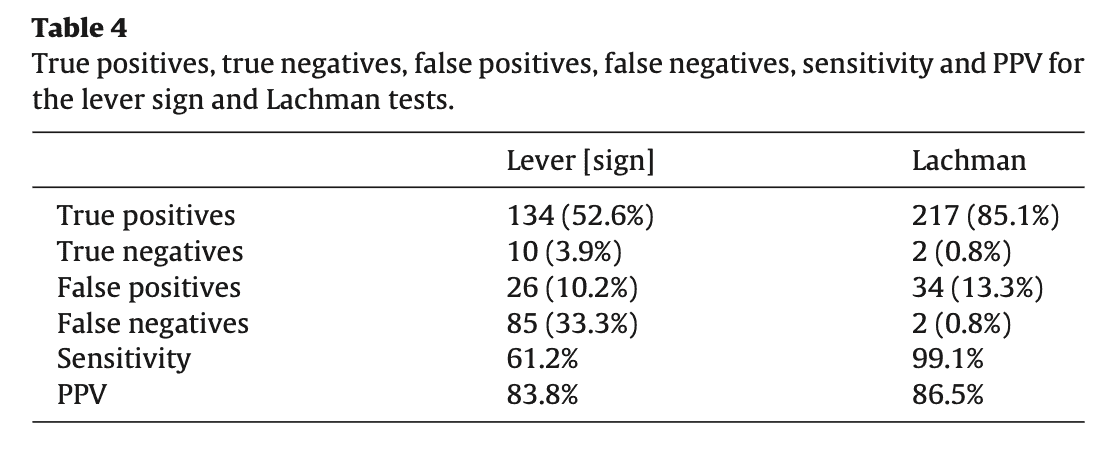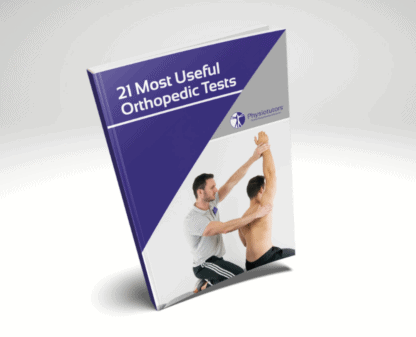Validity of the lever sign test for the clinical diagnosis of anterior cruciate ligament tears

Introduction
ACL tears can be confirmed using the anterior drawer, Lachman, and pivot shift tests. However, the diagnostic properties of these tests are not perfect, as shown by a meta-analysis by Benjaminse et al in 2006. The anterior drawer has a sensitivity of 49% and specificity of 58%, the pivot shift has a sensitivity of 32% and a specificity of 98% and the Lachman demonstrates 85% sensitivity and 94% specificity. From this meta-analysis, the Lachman would be the go-to option when you clinically suspect a torn ACL. However, the test may be difficult to perform especially in obese or in case the examiner cannot sufficiently grasp around the subjects’ leg. In 2014, Lelli et al. described the lever sign test and this seemed a valuable option since the difficulties encountered with the Lachman didn’t show up here at first glance. Two more recent meta-analyses reported some reservations about the validity of this test. In this study, the authors took into account these comments and tried to determine the sensitivity of the lever sign test for ACL tears in an acute primary care setting.
Methods
The subjects were recruited from 36 French ski resorts. Patients presenting with an acute knee injury (<7 days) where clinically a torn ACL was suspected (presence of cracking, instability, apprehension, effusion), and who had a normal RX were included. They were excluded in case they had had a torn ACL in the past (either treated surgically or not) or the RX showed associated fractures at the time of the initial visit.
258 patients were analyzed first by the lever sign test and then by the Lachman. The results were compared against an MRI which was completed after the clinical examination and which was considered as the gold standard. The results were summarized in 2×2 contingency tables to calculate the true and false positives and negatives. This information was used to calculate the positive predictive value (PPV) and sensitivity of the lever sign test for ACL tears.
The lever sign test can be conducted as follows:
Results
In total, 190 women and 68 men were examined with both tests. The MRIs revealed 219 ACL tears (84.9%). In 160 patients, the lever sign test was positive (62.7%) and 134 of these (83.8%) were confirmed by MRI. The Lachman test revealed 251 positive cases (98.4%) of which 217 (85.1%) were MRI-confirmed. The sensitivity of the Lachman and lever sign test for ACL tears was therefore 99.1% and 61.2% respectively. The PPV was determined to be respectively 86.5% and 83.8% for the Lachman and lever sign test.

Questions and thoughts
The authors only calculated sensitivity and the PPV of the lever sign tests as no true negatives were included in the study. Only with the inclusion of true negatives in the form of uninjured patients, the specificity and NPV can be determined.
A relevant side note to place here is that the setting (French ski resorts) allows finding many people presenting with acute knee injuries and the incidence of ACL tears therefore can be much higher than encountered in another primary care setting. This may influence the sensitivity and PPV values as determined here. Further, the results indicated that the lever sign test is a useful test that may supplement the Lachman or may replace the Lachman in case the latter cannot be performed appropriately or in case the outcome is uncertain.
Talk nerdy to me
The lever sign test for ACL tears was tested in a population with a high chance of the disease of interest being present. This may have led to an overestimation of the PPV. In case you want to read more about that, I refer you to the following blog post.
Summing up, it would be interesting to investigate how the test would perform in a setting where ACL tears can be expected to be much less. For its use in clinical practice, likelihood ratios are far more informative, but this fell beyond the scope of this study. Therefore, to interpret these findings presented here, one should bear in mind the setting in which you are performing the lever sign test.
Take home messages
The Lever sign test can be a supplementary test to use along with the Lachman test, especially when the latter is difficult or impossible to perform. Note that this study was conducted in a setting characterized by a high prevalence of ACL tears being present, which may overestimate the PPV. In 2019 Abruscato et al., in a meta-analysis showed promising values for the lever sign test: pooled sensitivity and specificity were 0.77 and 0.90, respectively and the negative likelihood ratio was 0.22 and the positive likelihood ratio 6.60. This difference in sensitivity may be due to the lever sign test performed here in an acute setting, which may complicate clinical examination due to, for example, acute swelling and apprehension.
Reference
Additional reference:
21 OF THE MOST USEFUL ORTHOPAEDIC TESTS IN CLINICAL PRACTICE
We have comprised a 100% Free E-Book containing 21 of the hands-down most useful orthopedic tests per body region guaranteed to help you reach a proper diagnosis today!



